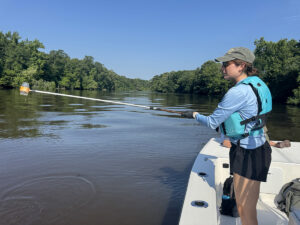News
Neuse River of the Year: Sound Rivers comments
Posted on October 18th, 2022

The following is the speech made by Sound Rivers Executive Director Heather Deck at American Rivers’ River of the Year event held Monday at Old Waynesboro Park, Goldsboro. Other speakers included N.C. Representative John Bell, Peletah Ministries Director Dr. Dawn Baldwin Gibson, U.S. Congressman G.K. Butterfield, U.S. Congresswoman Deborah Ross, American Rivers President Tom Kiernan, North Carolina Department of Environmental Quality Secretary Elizabeth Biser and EPA Administrator Michael Regan.
“This river is special.
The Neuse River — a historic river — is woven into the fabric of our towns’ histories; it is the lifeblood of our communities.
It is truly an honor to be standing here today, on the banks of this river, with so many of our local, state and federal leaders.
River of the Year is a wonderful recognition, and this year the designation is recognizing the work that has been done by communities along the river to reduce pollution, combat flooding and restore the health of our watershed.
At Sound Rivers, we strongly believe all of that work has to happen from the local level, up — everyone has a part to play in creating policy that protects the health of the river AND its people.
Sound Rivers’ two Riverkeepers on the Neuse and Pamlico-Tar Rivers just had the amazing opportunity to spend 10 days kayaking the Neuse River 150 miles from Smithfield to New Bern. In those 10 days, they were surrounded by unparalleled natural beauty; from the remote and undeveloped stretch of river just upstream of where we’re standing, to the Cliffs of the Neuse, the lowland swamps surrounding Kinston and the wide river at New Bern.
But what was even more impactful for our Riverkeepers was their interactions with the people they met on the river — people who shared heartwarming stories about their love of the Neuse, paddling the river and childhood fishing. They also shared troubling stories about the horrors of climate change and the devastating toll flooding has taken on this watershed.
We can all agree access to clean water, healthy rivers and vibrant communities is vital for our future. We all agree on that, and I think we can also agree — in the face of increasing threats from a changing climate — we must all work together to make sure this river, OUR river, is healthy for generations to come.
We’ve come a long way since the early days of dumping toxins directly into the Neuse, but many still bear the burdens of pollution, outdated infrastructure and flooding. Working together to address these issues in our watershed, that work BEGINS with our most vulnerable communities.
What we need is greater investment in our communities.
Right now, we have a unique opportunity to make significant changes for the Neuse River and all the people who rely on it — and to right the many environmental injustices that continue to stand. With the passage of important funding legislation by Congress and the General Assembly, the Neuse River needs our state and community leaders to prioritize investment in:
- safeguarding our communities from flooding and helping the Neuse watershed become resilient to climate change;
- updating sewage infrastructure, starting in our most vulnerable communities on the Neuse;
- investing $20 million in the state’s Swine Buyout Program to remove toxic pollution such as swine waste from flood-prone areas of the Neuse and its tributaries;
- restoring funding to our regulatory agencies so they are fully staffed and equipped to strongly enforce protections for the Neuse watershed.
Along with our partners, we’re asking for new executive action that is visionary, community-focused and active in the pursuit of environmental justice.
As Tom so eloquently noted in his comments, the story of the Neuse River, and, in fact, all of our North Carolina waterways, is still being written. But right now, it’s all of us — our local, state and federal leaders; our conservationists and community activists — who are its authors.
It’s our role to write 50 more years of progress into the next chapter of the Neuse River.”
Related News

Neuse fish kill expected to extend beyond holiday weekend
July 3rd 2025

Swim Guide fails prompt Maple Cypress investigation
July 3rd 2025

Riverkeeper, town partners root out source of Smithfield sediment pollution
July 3rd 2025

Trash trap No. 12 approved for Smithfield
July 3rd 2025

Sunset River Paddle fundraiser boosts Water Quality Fund
July 3rd 2025

Riverkeepers host quarterly Water Watch meeting
July 3rd 2025

Public hearing will determine the fate of many NC wetlands
June 26th 2025

Clayton gets first official trash-trap cleanout
June 25th 2025

